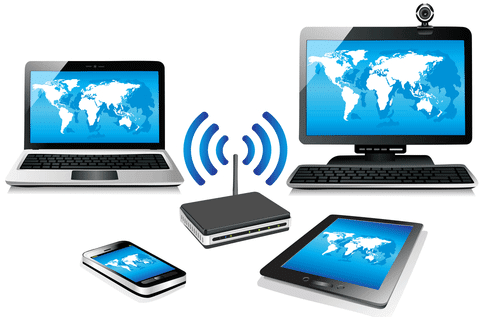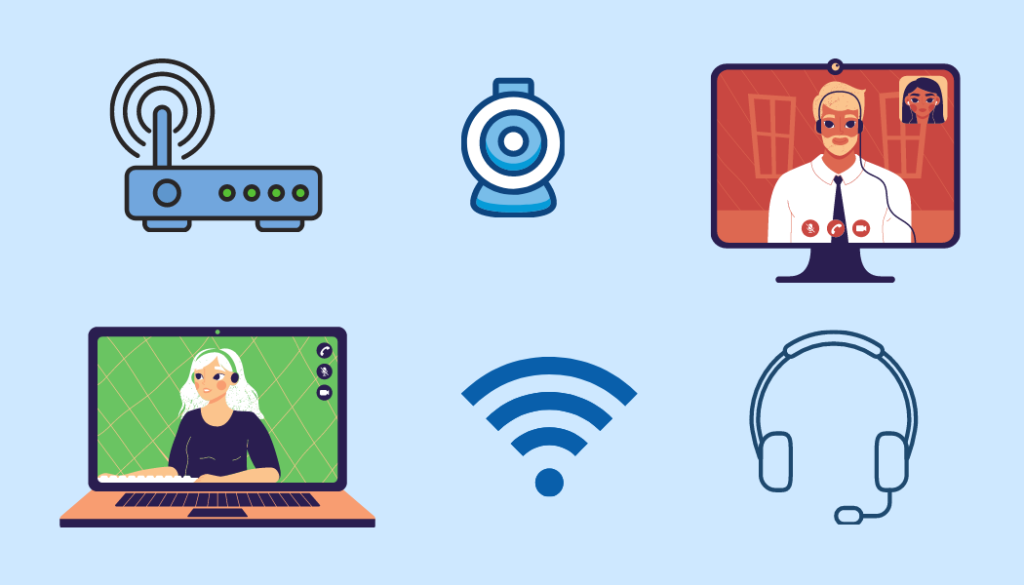With COVID bringing an influx of virtual meetings, many will experience some technical difficulties. During such a trying time, preserving resources is invaluable. Most employees’ schedules are jam packed with virtual meetings and events that are critical to business and project success. As the effects of COVID-19 have dramatically increased the importance of communication on virtual platforms like Zoom, Teams, and Slack, interruptions can be detrimental to success. If your team sets aside 30 minutes a week to discuss the status of your marketing efforts, it is crucial to the efficiency of the meeting for the virtual experience to run smoothly. We created this list to help you and your colleagues troubleshoot basic connectivity issues you may experience when using video conferencing platforms. Run through this list the next time your meeting is interrupted so your team spends less time troubleshooting and more time nailing the pitch your boss asked for.
Are you connected to Wi-fi?

Sometimes when working from home, we know it’s usually more comfortable to be seated at your dining room table, the living room couch, and (for the real comfort-seekers out there) even the bed. Unfortunately, choosing comfort might be sacrificing your virtual experience. If one is accessible at home, a wired connection is always more stable and reliable. If a wired connection is not possible you can get away with being as close to your router as you can. Whether this means moving the router closer to your workstation or moving your workstation closer to the router is entirely up to you.
Are you getting enough bandwidth?
Check your bandwidth using an online speed test. Go to SpeedTest.net and run a speed test. This will tell you approximately how many Megabits per second are being transmitted on your device. This number might seem familiar as the advertised package you have with your Internet Service Provider (Optimum, Verizon, etc.). If speeds are very low (less than ~20 Mbps) contact your Internet Service Provider for the next steps. ISPs sometimes throttle speeds to accommodate demand surges from other users in the area.
Are the people who aren’t talking in the meeting muted?
If someone isn’t talking, they should have their microphone muted to reduce feedback and background noise. Not only is background noise incredibly distracting, sometimes if a participant is not muted and there is a lot of background noise coming through their device, that noise can take priority over the participant that’s intended to be speaking. It is recommended to use headphones as they can also reduce microphone feedback. If your mic is not muted for whatever reason, be diligent about limiting actions like tapping your pen, organizing papers, and typing on a keyboard as this can also lead to a lot of unwanted mic feedback.

Are there others on your network?
Having a lot of traffic on your network can slow your connection. What may have not been a problem previously, we are all facing the difficulties associated with COVID restrictions. In many cases this means not only are there more people in the household on a day-to-day basis, but these people are doing many different things on multiple devices. Think realistically about what else may be going on your household network when you come across connectivity issues in your meetings. Do you have children in your home doing online schooling? Is your partner streaming on their phone, laptop, or Smart TV? Is your roommate also working from home and having a meeting at the same time? These scenarios can drastically change the performance of your device when trying to conduct a virtual meeting.
Are you streaming or using the web while in a virtual meeting?
While we can all be guilty of doing it on occasion, doing other work or indulging in distractions can alter the quality of the connection your device has in the meeting. As stated above, more network traffic can lead to a worse connection. That means YOU are also a factor you need to consider when thinking about what other activity is occurring on your network. Answering emails, scrolling Facebook, or streaming video content all eat at the available capacity of your network connection.
Are you connected to a VPN during your meeting?
If you are and don’t necessarily need it for that meeting, it is best to disconnect from the Virtual Private Network (VPN). If you’re not sure what a VPN is, this might not apply to you. If you’ll need to access files for a meeting, it may be best to store them locally and reupload the documents, if any edits are made, when you are connected to your VPN again.
Are you using both voice and video at this virtual meeting?
As a last resort, turn off your video and resort to just using voice capabilities. We know everyone loves to see each other’s bright and smiling faces but sometimes using both eats up a little too much data to maintain a stable connection. This can reduce the amount of data being consumed by the meeting and while it may be a bummer, it is better to have a voice meeting than no meeting at all.
These 7 suggestions have helped our team during this transition to optimize our virtual meetings. While sometimes we come across unforeseen interruptions due to things out of our control, such as: geographic location, inclement weather, etc., using the list above has helped us be more aware of the elements we are in control of and has led to better meeting quality.

